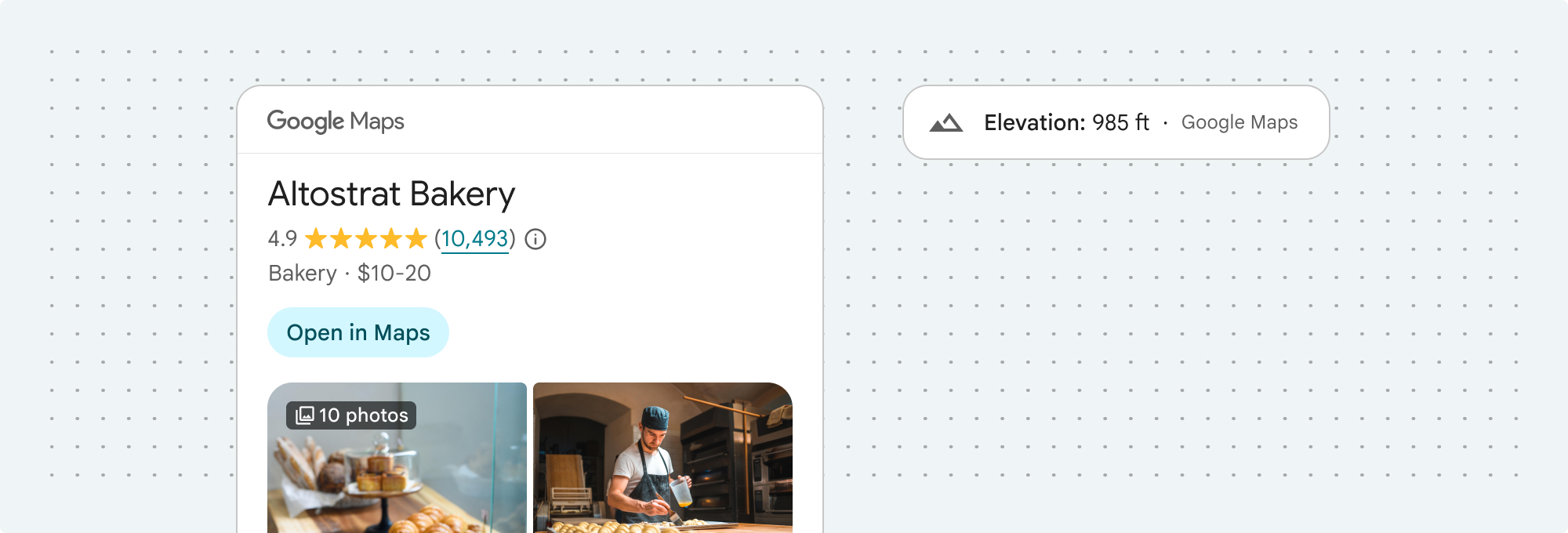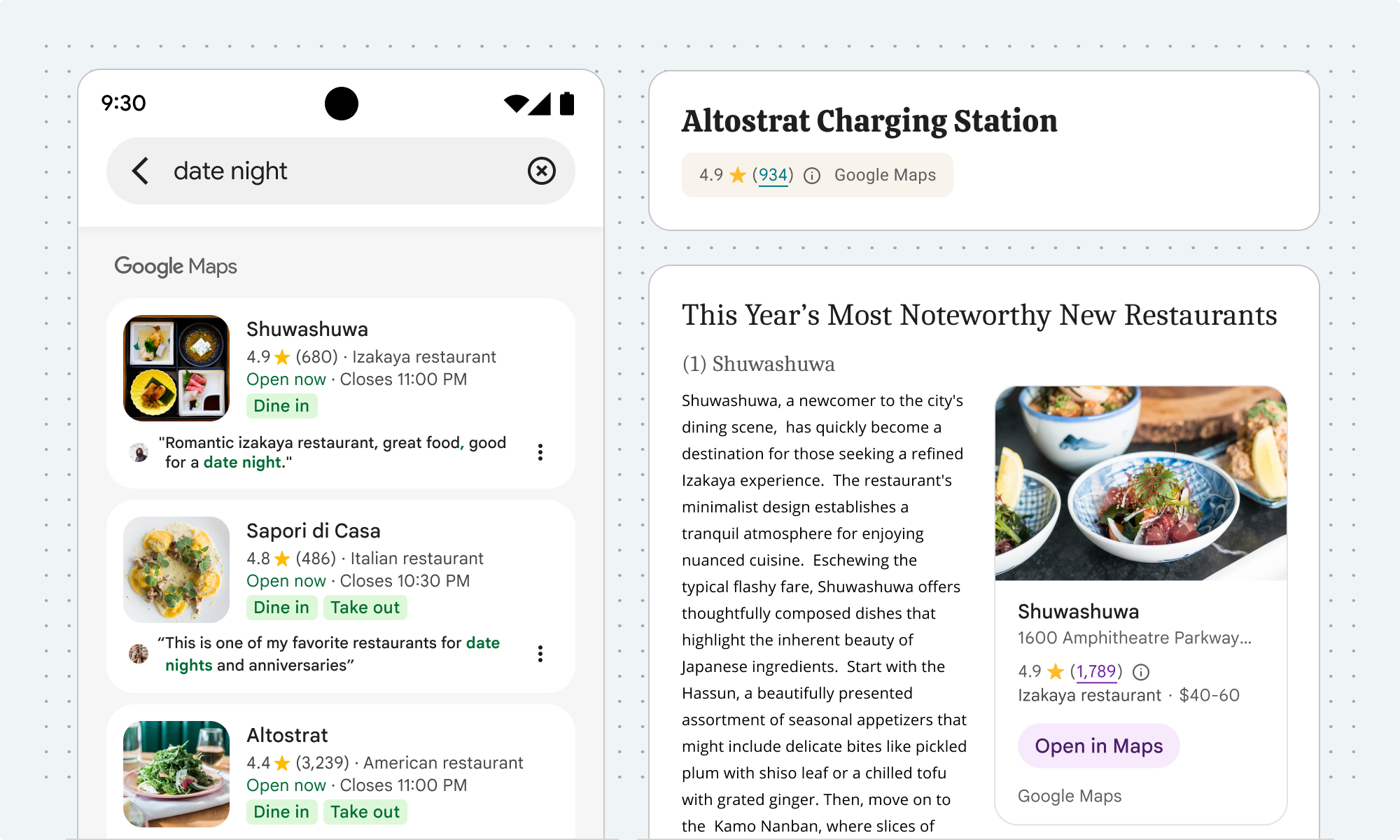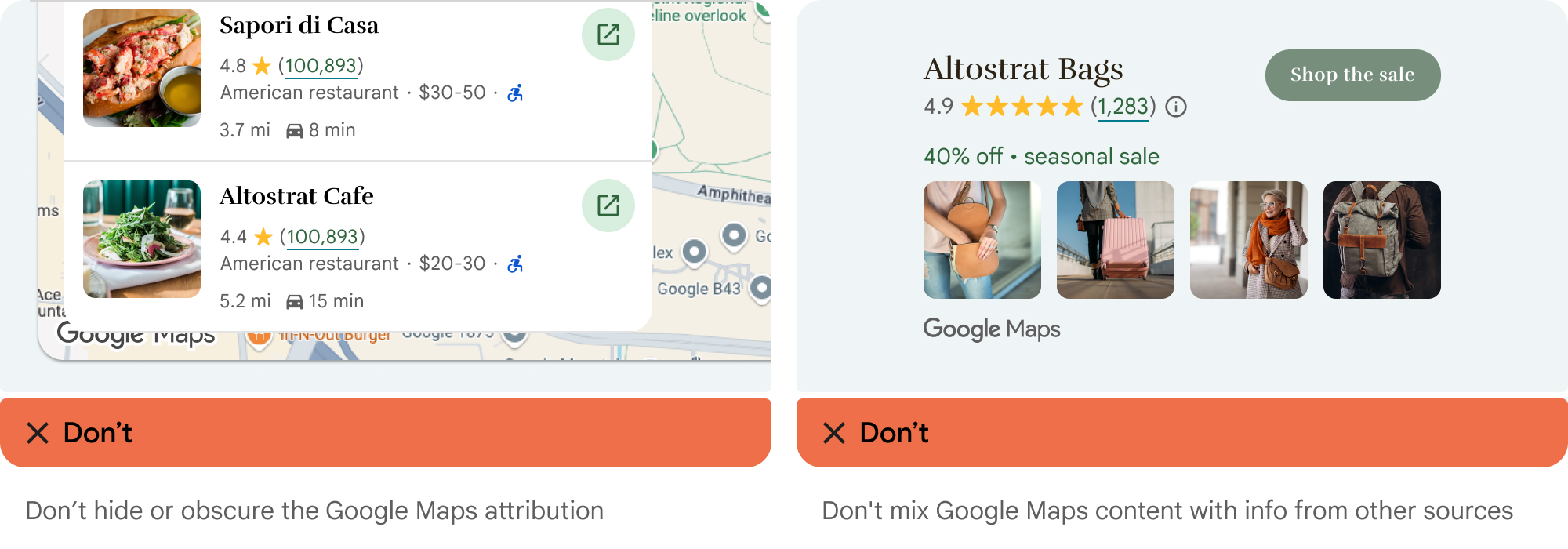本文列出使用 Places Insights 開發應用程式時的相關規定。請注意,使用地點洞察資料時,須遵守您與 Google 簽訂的協議。
政策
本節說明與地點洞察相關的政策。政策提供實用的導入指南和規定,協助您正確使用本服務,並符合 Google 地圖平台的期望。
快取限制的豁免條件
如要瞭解快取限制,請參閱服務條款。
Google 地圖 Places 內容政策
客戶確認並瞭解:
Google 地圖地點內容可能不準確,且會定期更新。
rating和user_rating_count資料是根據使用者評論計算出的統計資料。使用者評論未經 Google 驗證,但 Google 會檢查有無不實內容,一旦發現就會將其移除。
Google 地圖出處資訊規定
本節提供透過應用程式顯示 Google 地圖和內容的著作權聲明規定和指南。
顯示 Google 地圖出處資訊
在應用程式或網站中顯示 Google 地圖平台 API 的內容時,必須遵守 Google 地圖出處資訊規定。如果內容顯示在 Google 地圖上,且地圖已顯示出處資訊,則無須額外註明出處。
Google 地圖標誌和文字出處資訊
盡可能以 Google 地圖標誌的形式提供出處資訊。 如果空間有限,可使用「Google 地圖」。 必須讓使用者清楚哪些內容是由 Google 地圖提供。

標誌出處
在應用程式或網站中使用 Google 地圖標誌時,請遵守下列規定。
下載 Google 地圖標誌
使用官方 Google 地圖標誌檔案。請下載下方的標誌,並按照本節的規範使用。
下載 Google 地圖出處資訊資產使用 Google 地圖標誌時,請遵守下列規範。
- 請勿以任何方式修改標誌。
- 請維持標誌的顯示比例,避免變形。
- 在雜亂的背景 (例如地圖或圖片) 上使用輪廓標誌。
- 在純色或細微漸層等簡單背景上使用非輪廓標誌。
標誌大小規格
Google 地圖標誌的尺寸規格如下:- 標誌高度下限:16 dp
- 標誌高度上限:19 dp
- 標誌周圍至少應留空:左、右和頂端 10dp,底部 5dp
如要瞭解 dp,請參閱「Material Design」網站上的「像素密度」。

標誌可存取性
請遵守下列 Google 地圖標誌的無障礙規定:- 標誌和背景之間須維持可存取的對比度。
- 加入無障礙標籤,並附上「Google 地圖」文字。

文字出處
如果介面大小不支援使用 Google 地圖標誌,可以改用文字拼出 Google 地圖。請按照下列指南進行:

- 請勿以任何方式修改「Google 地圖」文字:
- 請勿變更「Google 地圖」的大小寫。
- 請勿將 Google 地圖換行
- 請勿將 Google 地圖本地化為其他語言。
- 使用 HTML 屬性
translate="no",防止瀏覽器翻譯 Google 地圖。

按照下表說明,設定 Google 地圖文字樣式:
Google 地圖文字樣式規定 屬性 樣式 字型系列 Roboto。載入字型為選用步驟。 備用字型系列 產品中已使用的任何無襯線內文字型,或「Sans-Serif」來叫用預設系統字型 字型樣式 一般 字型粗細 400 字型顏色 白色、黑色 (#1F1F1F) 或灰色 (#5E5E5E)。與背景維持無障礙(4.5:1) 對比度。 字型大小 字型大小下限:12sp
字型大小上限:16sp
如要瞭解 sp,請參閱 Material Design 網站上的「字型大小單位」。字母間距 一般
CSS 範例
下列 CSS 會在白色或淺色背景上,以適當的排版樣式和顏色顯示 Google 地圖。
@import url('https://fonts.googleapis.com/css2?family=Roboto&display=swap'); .GMP-attribution { font-family: Roboto, Sans-Serif; font-style: normal; font-weight: 400; font-size: 1rem; letter-spacing: normal; white-space: nowrap; color: #5e5e5e; }
視覺元素規定
請遵守下列規定,以視覺化方式呈現 Google 地圖出處資訊。將出處資訊放在內容頂端或底部附近,並位於同一個視覺容器中。如果是單行內容,出處資訊可以放在右側或左側。
使用邊框、背景顏色、陰影或足夠的空白空間等 UI 提示,從視覺上區分 Google 地圖平台內容和其他內容。
- 請勿將 Google 地圖與非 Google 地圖平台內容混用,以免誤導使用者。
- 確認出處資訊一律清晰可見。請勿移除、隱藏、遮蓋或修改。
下圖顯示這些視覺需求示例。




